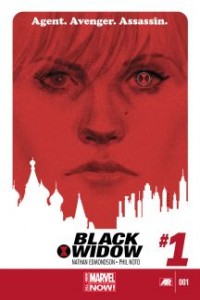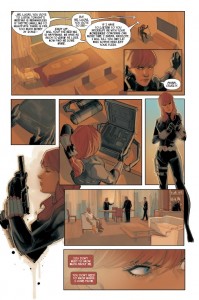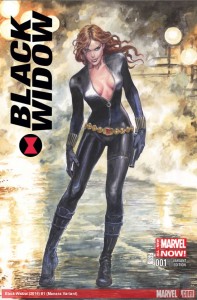Black Widow 1 & 2
Reviewed by Tony Keen 27-Jan-14
Black Widow seems like a comic worth sticking around for.
 Every right-thinking person knows that the one thing that Phase 3 of the Marvel Cinematic Universe needs above anything else is a Black Widow movie. (Actually, it also needs a Carol Danvers movie, and for the Wasp to be in both Ant-Man and Avengers 3, and not be rubbish in either of them, but for now let’s stick with what Marvel might actually give us.) Don’t listen to those who say “Yes, she’d be great, but it would be even better if she were a supporting character for a movie with a dude in the lead!”, whether that dude be Hawkeye, Bucky, Cap or Nick Fury. They are not right-thinking people – in fact they are being just as sexist as the idiots over at Warner Brothers who kept saying that Wonder Woman was just “too difficult” to put on screen.
Every right-thinking person knows that the one thing that Phase 3 of the Marvel Cinematic Universe needs above anything else is a Black Widow movie. (Actually, it also needs a Carol Danvers movie, and for the Wasp to be in both Ant-Man and Avengers 3, and not be rubbish in either of them, but for now let’s stick with what Marvel might actually give us.) Don’t listen to those who say “Yes, she’d be great, but it would be even better if she were a supporting character for a movie with a dude in the lead!”, whether that dude be Hawkeye, Bucky, Cap or Nick Fury. They are not right-thinking people – in fact they are being just as sexist as the idiots over at Warner Brothers who kept saying that Wonder Woman was just “too difficult” to put on screen.
Over at Marvel Comics, they are a bit better. True, for much of Natasha’s history she has been a supporting character in Iron Man, Avengers, Daredevil or Champions. But Marvel has been publishing Black Widow series since 1970, although most of the mini-series date to after 1999, and she didn’t get an ongoing series until 2010 (and that only lasted eight issues). Now here is another continuing series for her.
This is the Black Widow that we have known and loved since John Romita redesigned her in 1970, the red-headed super-spy in a skintight black jumpsuit, a combination of Natasha Fatale from Rocky and Bullwinkle (from whom Stan Lee surely took the Widow’s given name), Modesty Blaise and Emma Peel (with a touch of the Girl from U.N.C.L.E. thrown in). What we have here is similar to Matt Fraction’s Hawkeye, in that we are seeing what the Widow does when she’s not being an Avenger or working for SHIELD. However, where Clint runs a brownstone, Tasha, being who she is, acts as a non-profit ethical mercenary/assassin for hire.
 In issue 1, Nathan Edmondson delivers a nicely-paced script that delivers everything one expects of a first issue. Superheroics are kept to a sensible level – there’s nothing that wouldn’t be seen in, say, Alias. Overall, the first issue feels much like the pilot episode of a tv series. I mean no criticism by that – as a solo character, the Black Widow works when placed in a relatively realistic milieu, that would work as well on screen as on the page.
In issue 1, Nathan Edmondson delivers a nicely-paced script that delivers everything one expects of a first issue. Superheroics are kept to a sensible level – there’s nothing that wouldn’t be seen in, say, Alias. Overall, the first issue feels much like the pilot episode of a tv series. I mean no criticism by that – as a solo character, the Black Widow works when placed in a relatively realistic milieu, that would work as well on screen as on the page.
In issue 1, we see Natasha on a couple of missions, we’re introduced to a small supporting cast (Isaiah Ross, her lawyer-cum-manager, and a cat that is trying to adopt her), we get some hints of a big bad waiting in the wings, and are told that she is motivated by the idea of atonement for events in the past, events that she can’t forgive herself for, but over which she wants to draw a veil – a veil that will no doubt be lifted as the series goes on.
Indeed, the mission in issue 2 involves a flashback to Natasha’s past, as well as revealing more about Isaiah and what he is capable of, and further suggesting that there a lot of enemies out there for the Widow, and they are heading for her. To be honest, issue 2 is a bit of a formulaic repeat of issue 1, but establishing the formula before developing it is a perfectly legitimate thing to do.
Edmondson seems to be trying to approach the character with as clean a slate as possible – there’s no attempt to wipe out the Widow’s history with the Avengers and SHIELD, but there seems to be some attempt to transform the backstory, which was thoroughly rooted in the Cold War, into something more relevant to the world of the twenty-first century. Playfully, Edmondson gives us an origin of the Widow in the first two pages of issue 1, only for Tasha to repudiate it. (But how do we know when she’s lying and when she isn’t?) Edmondson’s Widow is burdened by guilt, but she manages to stay the right side of irritating self-pity. Nor does he fudge the issue of the fact that Natasha kills people.
Phil Noto’s artwork is painted, rather than being separate pencils, inks and colours, as appears to be Noto’s standard practice (I’m not very familiar with his work, though clearly this is remiss of me). It reminds me a bit of Bill Sienkiewicz’s on Elektra: Assassin. There’s the same soft focus around the lines, though Noto doesn’t go in for the abstraction that characterised Sienkiewicz’s work. It’s well-drawn, and the storytelling is clear, with only the occasional move into playfulness with comics vocabulary.
His depiction of the Widow looks real, in a way that isn’t always the case. She’s a beautiful woman, but not unbelievably so. Her outfit hasn’t been sprayed on, and she goes into action with it zipped up to her neck, not down to below her breasts. Of course, this has led some to moan that the sexiness is being taken away from the character. No doubt such readers are also disappointed at the lack of scenes in which the Widow is taking a shower, changing into her costume, or being viewed from behind when bending over. But they are silly people, who are catered to by other comics (mostly over at DC). Black Widow is a comic for people who want a realistically-depicted female superspy, with real characterization. (The complainers will have to be content with the Milo Manara variant cover.)Unless you count that depiction of a female who is neither over-sexualised nor a cardboard cut out, there is little spectacular or ground-breaking about Black Widow so far. It’s just good solid storytelling – well-told, well-illustrated. Which makes it definitely worth following. Let’s hope it lasts (the first issue selling out and being reprinted must be good news for that prospect). And anyone thinking of making a Black Widow movie could do worse than pay attention.
Tags: Avengers, Black Widow, Marvel, Nathan Edmondson, Phil Noto

Right on, Tony!
Speaking with my ‘Retailer Hat’ on, I have to say this is the comic Marvel should have released right after the Avengers movie – the number of young women and girls who came into the shop looking for a Black Widow title was remarkable, and we sold out of our back-issue stock within a week. The House of Ideas really missed the boat on that one! And the current series, while dark in certain areas, isn’t hopelessly unsuitable for younger readers or puerile and sexist in the way that some earlier iterations of ‘Tasha’s series were.
The best and most refreshing title out of the New Now – or whatever it’s called – releases.
Or at least it was until Ms Marvel, which I believe you are also going to be covering, Tony ?
Though it saddens me to say that after three issues the storytelling is getting very formulaic. Hopefully this will change soon.